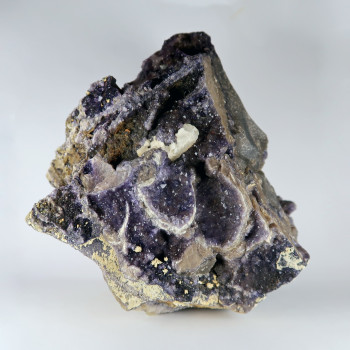Blue John
Blue John is a rather unique type of Fluorite which is only found around the town of Castleton, England.
It is typically clear, blue, and purple banded, and makes a nice decorative object when polished.
I have seen some true masterpiece carvings – handily, Fluorite is quite a soft stone. Blue John mining has largely stopped in Castleton, as there are only limited seams that are commercially viable – as such, the specimen price has increased quite a bit.
There is often talk of new seams being found, but no surplus of material ever seems to make its way onto the market.
Showing the single result
Appearance, Uses and History
Blue John is a banded Fluorite that occurs in several colours – yellow, purple, blue, green, white, and clear.
The best specimens occur in cubic formations, with other excellent pieces being ‘massive’, perfect for cutting into slabs.
Blue John is exclusively used as a decorative stone, used for jewellery, carved into decorative objects, or sold uncut, as mineral specimens.
This material has been used since around 1740 – 1765.
Locales
Blue John is only found in and around Castleton, England.
There appears to have been a find of a similar looking Fluorite from China, too.
Mineralogy
Some pieces are heat treated or irradiated.
Hazards and Warnings
Fluorite contains Fluorine, which on its own is extremely toxic. However, it is relatively safe when combined with Calcium, the other ingredient of Fluorite.
As dust, or in water or acid, however, it may not be as safe. People living near Fluorite mines have experienced side effects as a result of runoff into the water table.
Almost all rocks, minerals (and, frankly, almost all other substances on earth) can produce toxic dust when cutting, which can cause serious respiratory conditions including silicosis.
When cutting or polishing rocks, minerals, shells, etc, all work should be done wet to minimise the dust, and a suitable respirator or extraction system should be used.

